Published at: 2025-10-30
Sales Scope
1. Detailed Description of Sellable Scope
1.1 Preset Scenarios for Sellable Scope
- All
- The record owner is the current user or the current user’s subordinate.
- Or the related team includes the current user or the current user’s subordinate.
- Or in “Data Permission Management” the customer’s data sharing rule is configured to share records owned by the record owner or the owner’s department with the current employee, the current employee’s department, or the current employee’s user group.
- Or it is data under “My Responsible Departments”.
- My Responsibilities: the record owner is the current user
- Participated by Me: the related team includes the current user
- My Responsible Departments:
- The current user is the head of their primary department.
- And the related team members’ primary department in the record is that department.
- Note: Whether the responsible department includes all subordinate data is determined by CRM Management → Rules Settings → Basic Settings → “Upper-level visible data range”.
- Responsible by My Subordinates: the record owner is the current user’s subordinate
- My subordinates participated: the related team includes the current user’s subordinate
- Shared With Me: in “Data Permission Management” the contact’s data sharing rule is configured to share records owned by the record owner or the owner’s department with the current employee, the current employee’s department, or the current employee’s user group
Note: - CRM administrators can view all data. - Only CRM administrators can see records with status “Cancelled”; others cannot.
1.2 Sellable Scope Operations
1.2.1 Sellable Scope Toggle
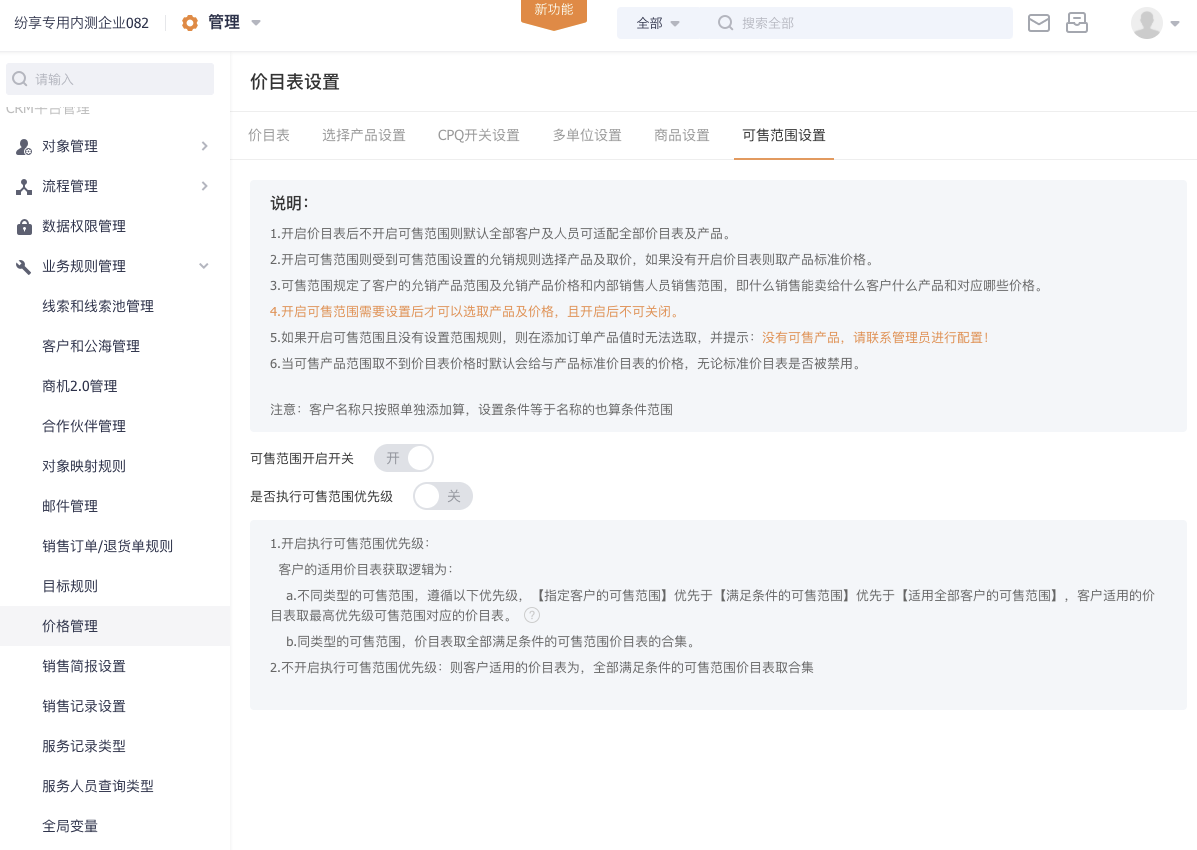
- Sellable Scope switch:
- Once enabled, it cannot be turned off.
- After enabling, Sales Orders, Quotations, and Opportunity 2.0 will request the selected Account/or Partner’s applicable Sellable Scopes, including sellable Products and applicable Price Lists.
- Execute sellable-scope priority? (see section 4.3 for details)
- Priority order: [Sellable Scope for specified Accounts] > [Sellable Scope that meets conditions] > [Sellable Scope that applies to all Accounts]
- If enabled: respect priority
- If multiple Sellable Scopes exist and their “Applicable Accounts” differ: the Sellable Scope with higher priority applies.
- If multiple Sellable Scopes exist and their “Applicable Accounts” are the same: the effective Sellable Scope is the union of those Sellable Scopes.
- If not enabled: use the union of multiple Sellable Scopes.
1.2.2 Create a Sellable Scope
(1) Ways to create a Sellable Scope - Manual: from the Price List list page - Import: supports importing parent-child records only when adding new data for both
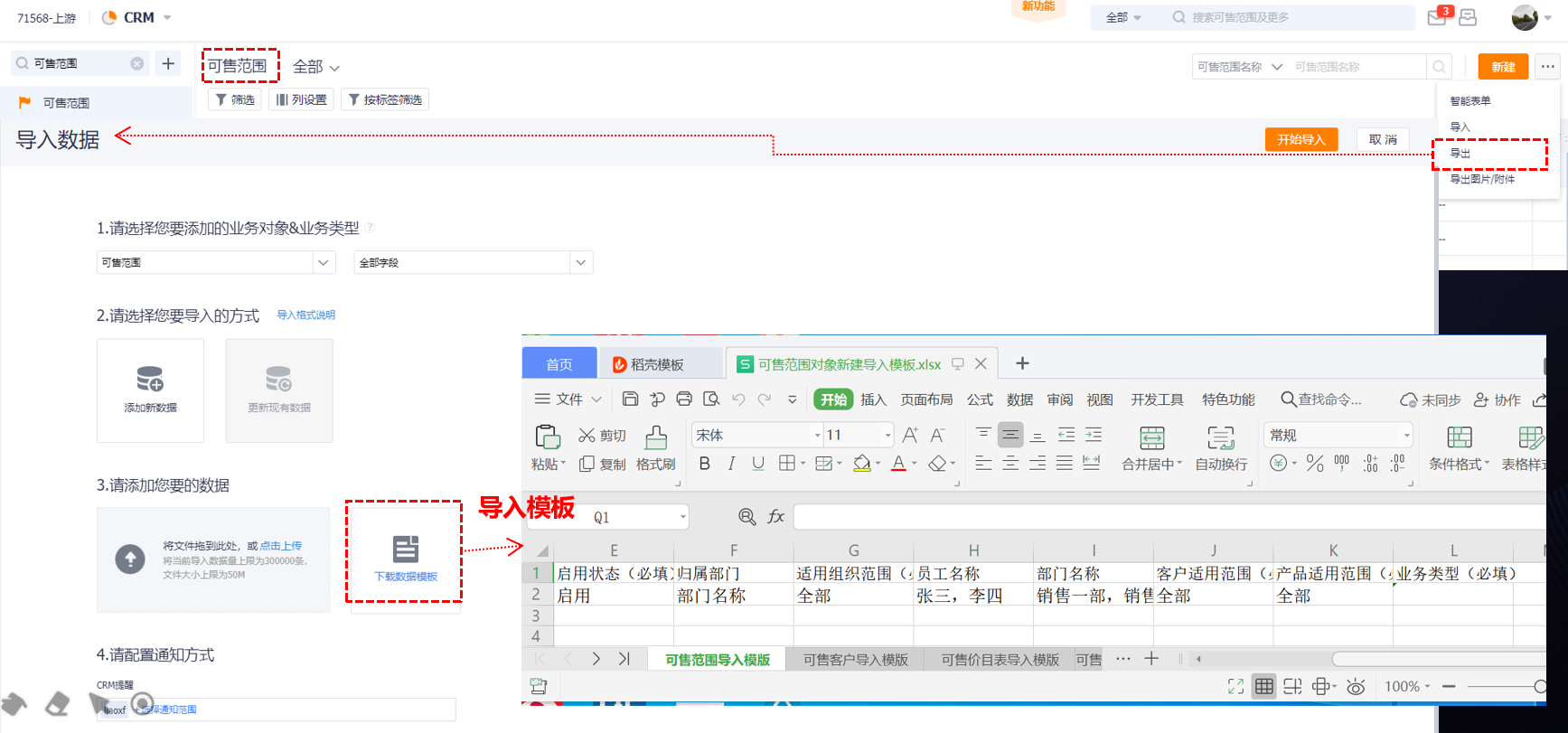
- Import supports specifying Accounts or specifying Products (condition-based import is not supported)

(2) Business rules for creating a Sellable Scope
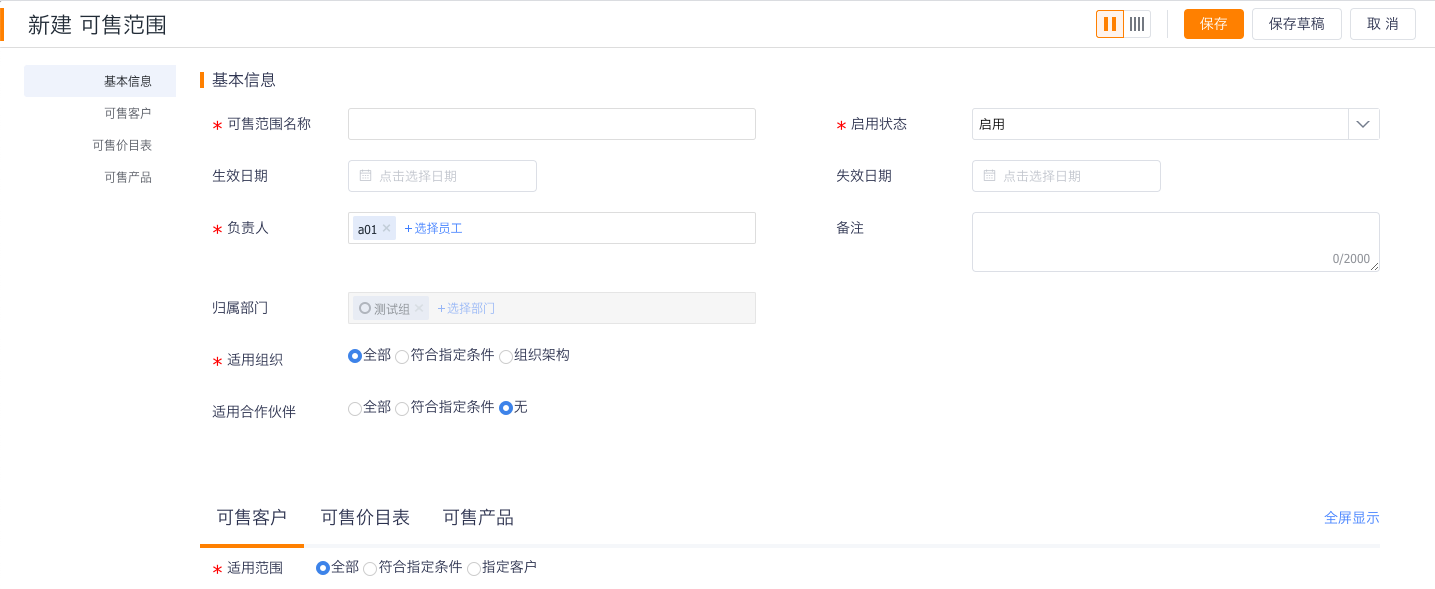
- Sellable Scope Name: name as needed (e.g., Level XX 2020 Sellable Scope)
- Status: Enabled / Disabled. When Enabled: Quotations, Sales Orders, Opportunity 2.0 creation, edit, copy, mapping, and adding historical order lines will validate against this Sellable Scope. When Disabled: no validation.
- Effective Date: Sellable Scope start date (starts at 00:00). If not set, no start limit.
-
Expiration Date: Sellable Scope end date (ends at 24:00 on the day). If not set, no end limit. Orders, Quotations, and Opportunity 2.0 created between Effective Date (inclusive) and Expiration Date (exclusive of next day 00:00) are constrained by the Sellable Scope.
- Applicable Organization: users inside this organization are constrained by this Sellable Scope
- All: all users in the organization
- Meet specified conditions: define organization based on fields on the User (Person) object

- Org Structure: set organization based on Colleague or Dept.
- Colleague: specify individual colleague(s)
- Dept.: if user is in their primary department, child departments are included by default; if not the primary department, child departments must be selected explicitly

- Applicable Partners: (available when Partner functionality is enabled)
- All: all Partners are applicable to this Sellable Scope. If a Quotation, Sales Order, or Opportunity 2.0 does not select a Partner, it is not constrained by this Sellable Scope.
- Meet specified conditions: define Partners by fields on the Partner object

- None: no Partners are applicable to this Sellable Scope; downstream documents cannot match a Sellable Scope for Quotations, Sales Orders, and Opportunity 2.0

- Partners cannot use Standard Price Lists.
(3) Add Sellable Accounts
- Business description: add Accounts to a Sellable Scope so that when creating a Sales Order, Quotation, or Opportunity 2.0 and selecting an Account, the scope defines whether all Accounts, a group of Accounts, or specific Accounts are constrained by this Sellable Scope.
- Three scenarios:
- All: all Accounts are constrained by this Sellable Scope
- Meet specified conditions: a group of Accounts defined by Account fields are constrained by this Sellable Scope
- Conditions can be combined with AND or OR
- AND: must satisfy all; up to 5 AND conditions
- OR: satisfy any; up to 5 OR conditions
- Conditions can be combined with AND or OR
- Specified Accounts: add specific Accounts from the Account list with “Add row” or “Bulk add by Account name”


Scenarios: 1. When Accounts are added, modified, or removed, how to operate the Sellable Scope? - If Sellable Accounts are set to All or Meet specified conditions: because the condition is evaluated dynamically, no action is needed. - If Sellable Accounts are set to Specified Accounts: if Accounts change and need to be constrained by a Sellable Scope, you must add/modify/remove those Accounts in the corresponding Sellable Scope → Sellable Accounts. 2. When fields on Account records change, how to operate the Sellable Scope? - Updates of the Account (or Partner) object — e.g., adding Contacts, changing Account fields like Account Level, Account Contact, Account Owner — are evaluated automatically. This does not affect whether the Account remains selected by the Sellable Scope. Therefore, no action is required for Sellable Scope or Sellable Accounts when Account fields change.
(4) Add Sellable Products
- Business description: add Products to a Sellable Scope so that after selecting an Account in a Sales Order, Quotation, or Opportunity 2.0 and adding line items, the available Products are constrained to either all Products, product groups, the Products included when adding Price List details, or specified Products.
- Four scenarios:
- All: all Products are constrained by this Sellable Scope

- Meet specified conditions: a group of Products defined by Product fields are constrained
- Conditions can be AND or OR
- AND: must satisfy all
- OR: satisfy any
- Conditions can be AND or OR
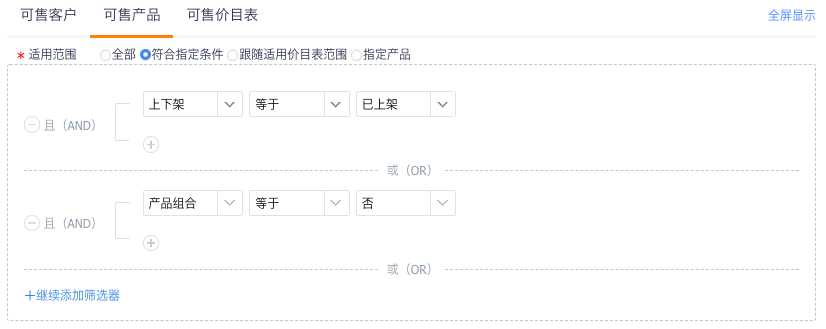
- Follow applicable Price List products: Products match those added when selecting partial Price List details
- Specified Products: add Products from the Product list with “Add row” or “Bulk add by Product name”


Scenarios: 1. When Products are added, modified, or removed, how to operate the Sellable Scope? - If Sellable Products are set to All, Meet specified conditions, or Follow applicable Price List products: the condition is evaluated dynamically, so no action is required. - If Sellable Products are set to Specified Products: if Products change and need to be constrained by a Sellable Scope, update the corresponding Sellable Scope → Sellable Products to add/modify/remove Products. 2. When Product object fields change, how to operate the Sellable Scope? - Updates to Product (e.g., change of owner, status, product Code, barcode, etc.) are computed automatically and do not affect whether a Product is selected by the Sellable Scope. Thus, no action is required for Sellable Scope or Sellable Products.
(5) Add Sellable Price Lists:
- Business description: add Price Lists to a Sellable Scope so that when adding line items after selecting an Account in a Sales Order, Quotation, or Opportunity 2.0 via “Add products” or “Add from Price List details”, the selected Product price can be obtained from which Price Lists.
- The final price for a selected Product is from the Price List with higher priority:
- Enforced priority: when adding “From Products”, the priority is enforced and users cannot switch Price Lists.
- Non-enforced priority: when adding “From Price List details”, users can switch to other Price Lists to get other Price List prices.
- The final price for a selected Product is from the Price List with higher priority:
- Add method: add from the Price List list; supports “Add row” and “Bulk add by Price List name”

Scenarios: 1. When Price Lists are added, modified, or removed, how to operate the Sellable Scope? You must adjust Sellable Scope → Sellable Price Lists accordingly. - Method 1: when Price List changes, use a quick action to add or sync to existing Sellable Scopes (in development; planned for v7.3.0). - Method 2: find the corresponding Sellable Scope, open “Sellable Price Lists” and add/modify/remove Price Lists. 2. When Price List object fields change, how to operate the Sellable Scope? - Updates to Price Lists (e.g., add/remove Products, modify effective date ranges, prices, discounts) do not affect whether a Price List is selected by a Sellable Scope. Therefore, no action is required for Sellable Scope → Sellable Price Lists.
1.3 Sellable Scope Priority Explanation
This section expands on the “Execute sellable-scope priority” toggle described in 1.2.1.
- Business: When multiple Sellable Scopes exist, which Sellable Scope constrains a Sales Order, Quotation, or Opportunity 2.0 (after selecting an Account or Partner) is determined by the “Execute sellable-scope priority” toggle.
- Sellable Scope for specified Accounts: Sellable Scope → Sellable Accounts → Applicable = Specified Accounts
- Sellable Scope that meets conditions: Sellable Scope → Sellable Accounts → Applicable = Meet specified conditions
- Sellable Scope that applies to all Accounts: Sellable Scope → Sellable Accounts → Applicable = All

- Multiple Sellable Scopes in effect:
- If “Execute sellable-scope priority” is enabled:
- If the Sellable Scopes’ Sellable Accounts “Applicable” settings differ: only the highest-priority Sellable Scope applies
- Differing “Applicable” means some scopes use All, some use Meet specified conditions, some use Specified Accounts.
- Priority applies when confirming which Sellable Scope applies after selecting an Account in Sales Orders, Quotations, or Opportunity 2.0.
- Priority order: Specified Accounts > Meet specified conditions > All
- If the Sellable Scopes’ Sellable Accounts “Applicable” settings are the same: multiple Sellable Scopes all apply (effective result is the union).
- Same “Applicable” means all are All, or all are Meet specified conditions, or all are Specified Accounts.
- In this case, priority does not apply; all Sellable Scopes take effect.
- If the Sellable Scopes’ Sellable Accounts “Applicable” settings differ: only the highest-priority Sellable Scope applies
- If “Execute sellable-scope priority” is disabled:
- Regardless of whether the “Applicable” settings are the same, multiple Sellable Scopes all take effect.
- If “Execute sellable-scope priority” is enabled:
1.4 Sellable Scope Approval Flow
The Sellable Scope object supports Approval Flow functionality.
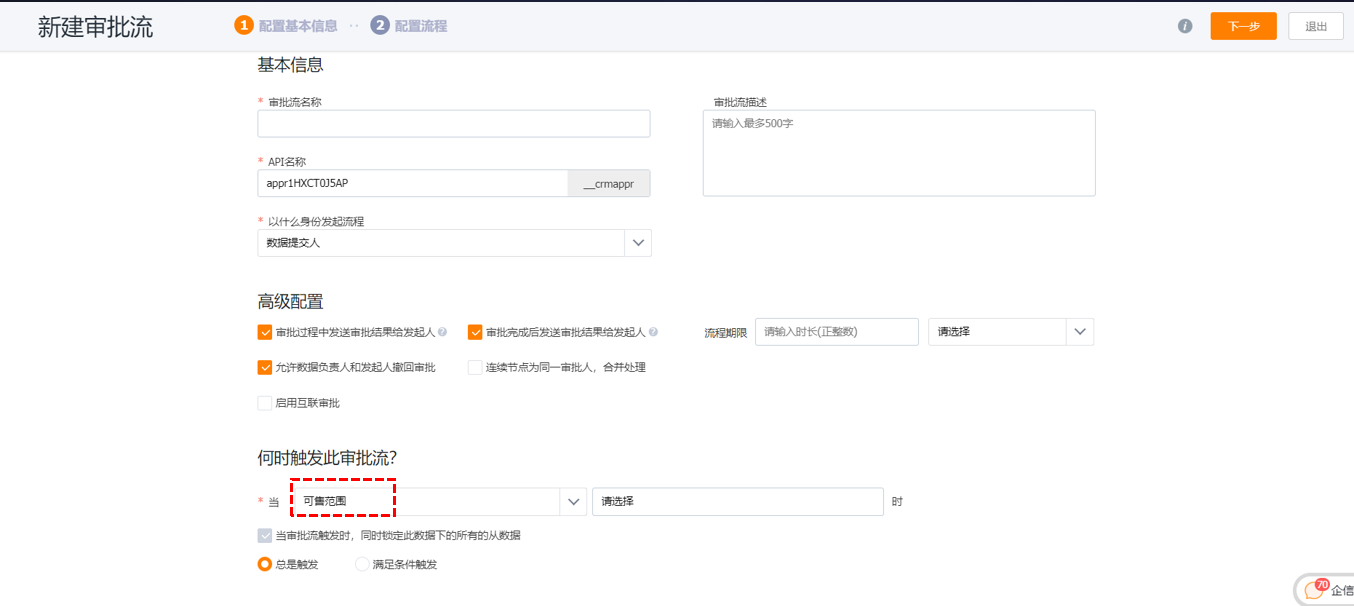
2. Impact on Other Objects
- Sales Orders, Quotations, Opportunity 2.0
- Price Lists enabled
- When Sellable Scope is enabled, during create/edit/copy/map/add historical order lines:
- The Price Lists the user’s primary department can use for the selected Account are determined by Sellable Scope → Sellable Price Lists.
- Order Products can only be added from Sellable Scope → Sellable Products.
- Order Product prices are taken from the higher-priority Price List defined in Sellable Scope → Sellable Price Lists.
- If priority is not enforced: when using “Add from Price List details”, after obtaining the higher-priority Price List price, user can switch to other Price Lists.
- If priority is enforced: when using “Add from Products”, after obtaining the higher-priority Price List price, user cannot switch to other Price Lists.
- When Sellable Scope is not enabled:
- Standard Price Lists are available company-wide for all Accounts.
- Order Products can be added from the Standard Price List.
- Order Product prices come from the Standard Price List.
- When Sellable Scope is enabled, during create/edit/copy/map/add historical order lines:
- Price Lists disabled
- When Sellable Scope is enabled:
- Behaves similarly to the “Price Lists enabled + Sellable Scope enabled” case, but Order Product prices are taken from the Product’s price field.
- When Sellable Scope is not enabled:
- No Price Lists
- Order Products can add all Products
- Company-wide product prices (from Product record) apply
- When Sellable Scope is enabled:
- Price Lists enabled
-
Other objects: not affected unless explicitly integrated.
-
Currently unsupported: other objects cannot invoke Sellable Scope or Price Lists.
-
The previous strict requirement “select Price List before Product/details after choosing Account in Sales Order, Quotation, Opportunity 2.0” is removed.
- Line-item adding logic by entry:
- From Products:
- Products: shows only the Sellable Products list for that Account.
- Price:
- Enforced priority: price from the higher-priority Price List for the Product.
- Non-enforced: this entry is not shown; after filling Product, user can switch Price List & Price List detail on the Order Product lines.
- Add historical order products:
- Products: shows only the Sellable Products list for that Account.
- Price:
- Enforced priority: price equals the most recent Order Product detail price from the higher-priority Price List.
- Non-enforced: default to the higher-priority Price List and its Price List detail price; after filling Product, user can switch Price List & Price List detail on the Order Product lines.
- From Price List details:
- Products: shows only the Sellable Products list for that Account.
- Price:
- Enforced priority: this entry is not shown.
- Non-enforced: default to the higher-priority Price List and its Price List detail price; user can switch Price List & Price List detail on the Add Product page.
- From Products:
- Switching Price List & Price List detail: when priority is not enforced, users can switch after filling order products.
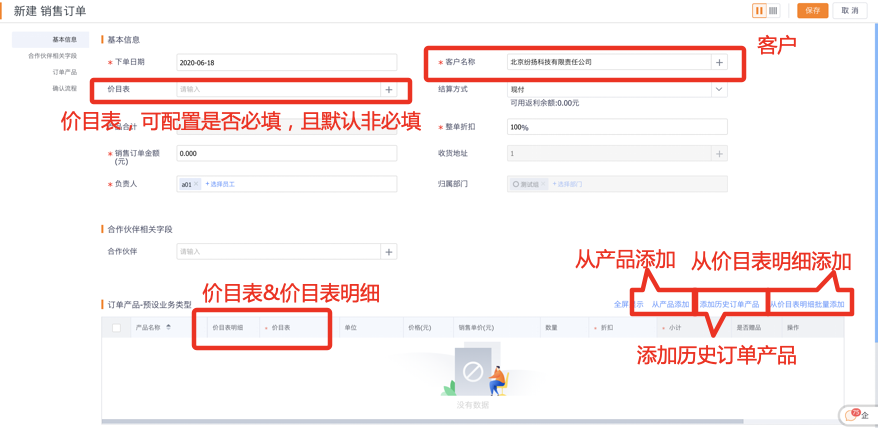
- The “Enforce best Price List priority” toggle determines behavior in Sales Order, Quotation, Opportunity 2.0:
- When adding line items:
- If enabled: hide “Add from Price List details” button.
- If disabled: hide “Add from Products” button.
- After selecting a Product, whether users can switch to other Price Lists:
- Enabled: cannot switch.
- Disabled: can switch.
- When adding line items:
-
Behavior also depends on whether sellable-scope priority is executed (see 4.3).
- Quotation-specific changes:
- Historical Quotations: show all historical Quotations for Sellable Products for that Account.
- Most recent transaction price: the most recent Order Product detail for that Sellable Product.
- Most recent Quotation: most recent Quotation detail for that Sellable Product.
- When reusing historical quotation data above, the system takes the latest price according to Sellable Scope and Price List priority, not the historical price.

- Copying Sales Orders, Quotations, Opportunity 2.0: when reusing line items, the system takes the latest price according to Sellable Scope and Price List priority.
- Mapping Opportunity 2.0 → Quotation, Quotation → Sales Order: when reusing line items, the system takes the latest price according to Sellable Scope and Price List priority.
3. Price Inquiry Tool
3.1 Name and Permission Location
- Feature name: Inquiry Tool
- Permission location: Business Feature Permissions → Role Permissions → Price Lists → Inquiry Tool. By default this permission is not checked. Administrators may enable it for relevant Roles based on business needs.
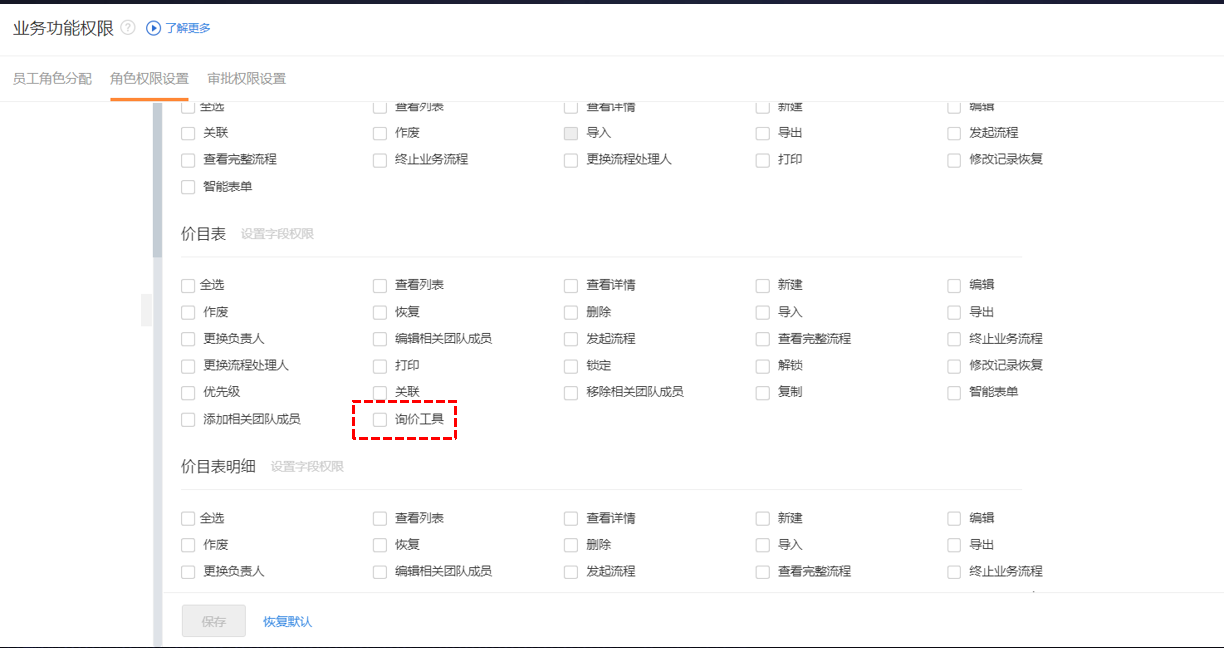
3.2 Inquiry Entry
Location: the Home widgets module.

3.3 Three Inquiry Modes Supported
Switch Tabs per business scenario. Default tab: Customer & Product price lookup.

3.3.1 Customer & Product Price Lookup
Shows which Sellable Scopes apply to the Account, the Sellable Scope priority order, and which Price Lists within those Sellable Scopes contain this Product, including their Price List priorities.
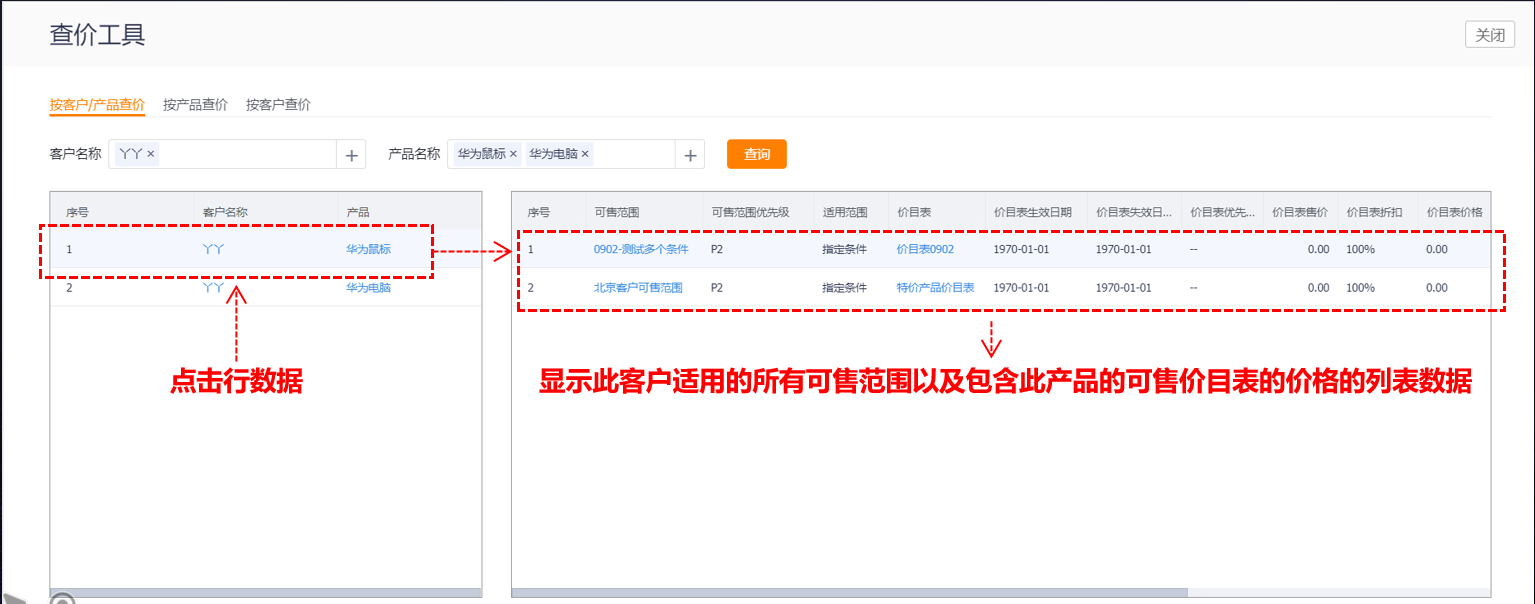
3.3.2 Product Price Lookup
Shows which prices a Product can be sold at, the Price List priority for those prices, and which Sellable Scopes include the Product.
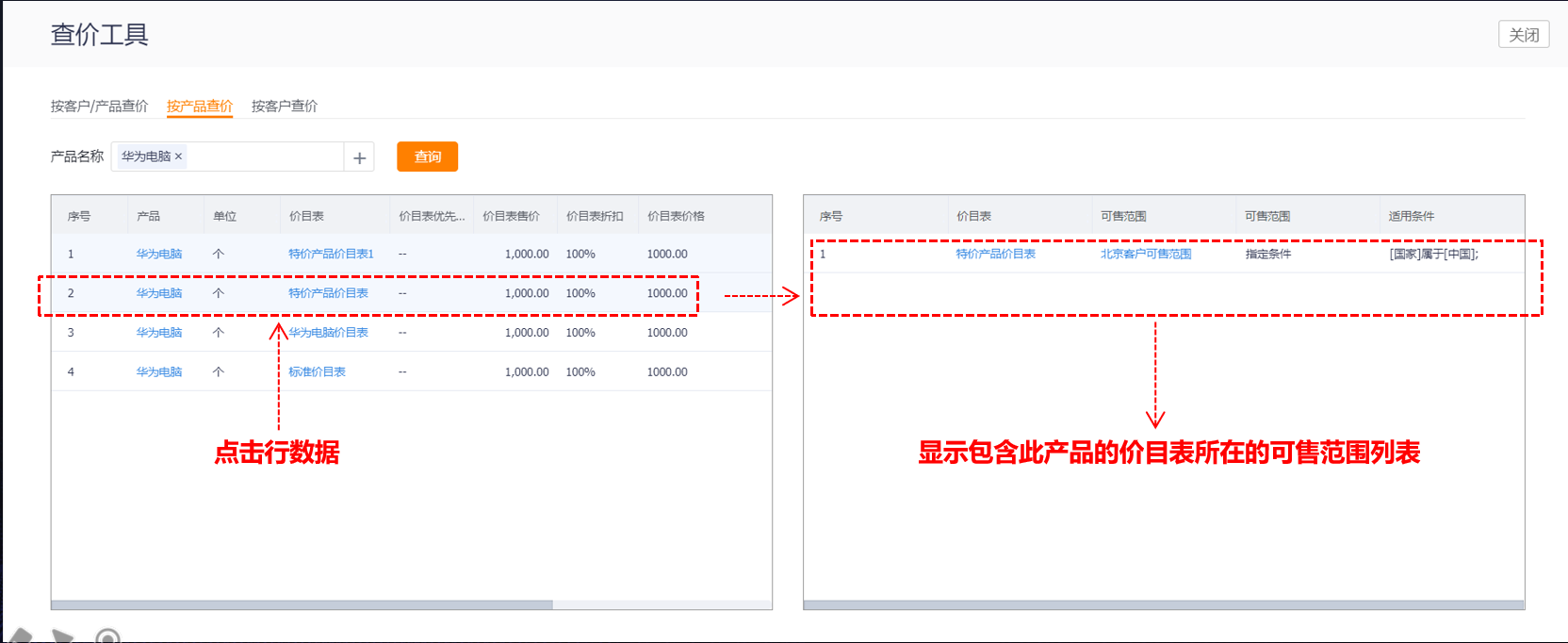
3.3.3 Customer Price Lookup
Shows which Sellable Scopes the Account has and which Price Lists are included in those Sellable Scopes.
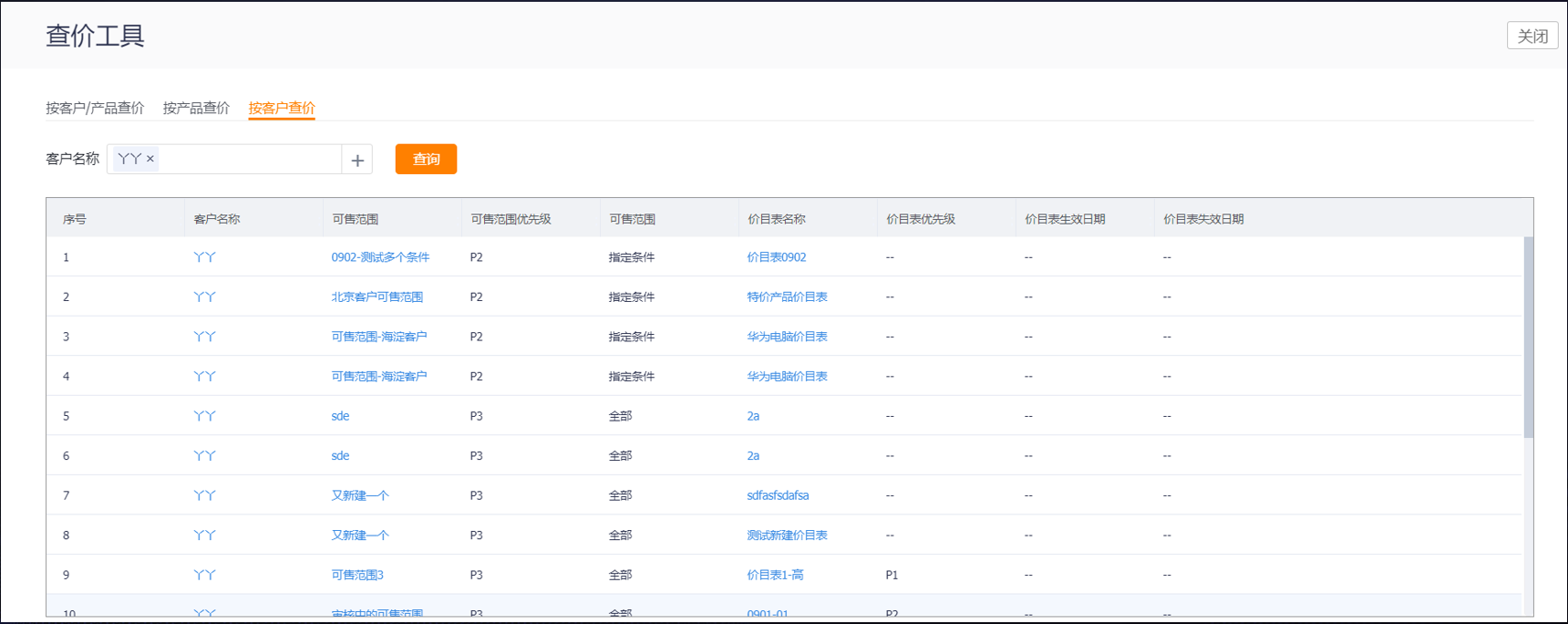
4. Planned Upgrades
- The Inquiry Tool supports quick price lookup by Customer & Product, Customer, and Product dimensions.
- The related Price List page will display a Price List priority field.
- Sellable Accounts will support viewing the list of Accounts that meet specified conditions.
- Sellable Products will support viewing Products that meet specified conditions and Products that follow applicable Price List product ranges.
- When creating/editing Products, a quick action will allow adding them to Price Lists.
- Price Lists will support quick addition to Sellable Scopes.
- Sellable Scope import will be supported (import for “Meet specified conditions” will not be supported).